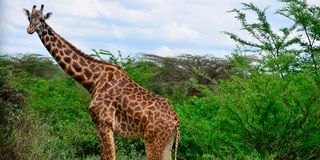Morning safari at Nairobi National Park

A giraffe grazes at Nairobi National Park on October 31, 2020.
The Nairobi National Park carries the worldwide reputation of being the only park in the city. Take a minute to let that sink in. You are privileged to be living in Kenya! But have you been patriotic enough to visit any park in your home country as an adult, or your only claim to glory is the single courtesy visit you made there while in primary school?
I was elated when I got the opportunity to accompany our guest for an early morning drive through the park.
My alarm went off at 5am sharp. I got out of bed despite the gloomy weather. Thankfully, my to-go cup of coffee kept me warm and caffeinated. I arrived at the park 45 minutes later. The numbing cold cooled my coffee before I drank it all. I quickly downed it as I walked to the park's coffee shop for more. It was, however, closed! It seems they don't catch worms here. Are morning drives not that popular?
For entry fees, we paid Sh430 each, and Sh1,030 for the van. I felt relieved when I switched my thoughts from work mode to pleasure mode, thanks to a friendly guide behind the wheel. We drove via a narrow natural green path that opened out to the full grass plain, which was dotted with acacia bushes and rustic brown earth treks. The seasons had just shifted, but the traces of the hot first quarter of the year could be seen in the few carcasses of wild animals we spotted on our way. Death is so cruel.
The impalas are always the most visible. They glided on the plentiful grass available to them in pairs. A flock of female impalas on the road swiftly fled at the rumble of our four-wheel drive, while the horned males stood calm. We also spotted a black mother rhino and her drowsy newborn on the ground, with an Oxpecker feeding off the rhino’s skin to get rid of pesky insects. She is known as “askari wa kifaru” as it doubles up as the rhino’s guard, alerting it of incoming predators.
Our driver navigated his way around the park, following directions only he could comprehend. We passed a dam that I thought would draw animals this early in the morning, but it was still an Instagram aesthetic with the reflection of the now-clear blue skies. We observed a couple of giraffes grazing in the distance, rising tall over the undergrowth, stuffing themselves full.
The driver coordinated with other vans via walkie-talkie to find out where the action was. This time, we were getting close to the famous SGR that snakes its way through the park. There were no animals here, but it reminded me of a historical prophecy about an iron serpent from the Nairobi-Uganda railway. Mischievous monkeys were all over jumping from one trash can to another as others watched from the trees.
He remarked as we drove off again in search of adventure, "It seems like a slow morning." I expected to see leopards, lions, and elephants, however, elephants were not among the numerous animals in the park due to the park's smaller size. Huge mammals could not fit in this 45-square-mile area over the years due to its proximity to the city and human invasion. Fortunately, our guide heard about the lions at 2B.
There were other vehicles and four-wheeled self-drivers there, all hoping to catch a glimpse of the big five cats. I'd never seen them up close before! They were only a few steps away. The other vehicles moved on one by one, bringing us even closer. This pride of lionesses suddenly popped up on a young male, chasing it across the road. The driver said that the male lion would kill a cub that was not his and that this was a warning not to approach the cub. This bustle enthralled everyone watching as they attempted to capture the moment. A group of female lions walked to the crossroads, undisturbed by the vehicles and people staring at them. These magnificent sand-brown cats were a sight to behold. They seemed peaceful for the most dangerous creature in the bush as they stared back.
We marvelled over the short and wonderful experience, our heads peeking out the sunroof, but we had one more visit - the ivory burning site, which holds an agonizing dramatic story in heaps of burnt-down fragments of ivory set ablaze by Kenyan presidents over the years. This gruesome sight serves as a stark reminder of the importance of protecting wildlife and the natural environment, and it is a critical battle for the future of biodiversity growth.
Apart from game drives, there are camping sites, Nairobi Safari Walk, an animal orphanage, and hotels to explore in the park.





